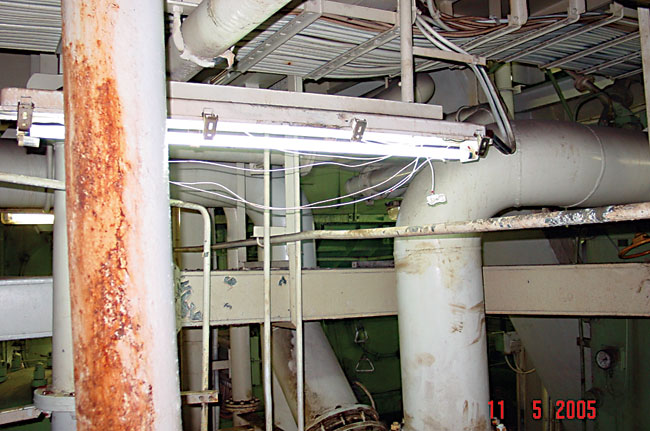COMMENTS AND ANALYSIS
On 13 May 2005 investigators from the ATSB conducted interviews with the master and chief engineer on board Probo Panda. Discussions were held with local police, the ship's agent and legal representative.
A postmortem examination of the electrician was conducted by the coroner in Rockhampton. The coroner's report was provided to the ATSB and cited the cause of death as coronary artery occlusion (heart attack) attributable to coronary artery atheroma (a build up of fatty patches inside the lining of the coronary arteries).
The contents of the electrician's pockets, which included tools, insulating tape, starters and old tube end fittings, and the fact that a new tube end fitting was found hanging from the light fitting (Figure 3) indicate the electrician had been in the process of changing this item.
The light fitting was situated directly above a transverse deep frame outboard of the main engine charge air cooler cleaning filter, starboard aft at the bottom plate level.
The light fitting was still live, with its circuit breaker closed and no danger tags fitted. Prior to the ATSB's arrival, the ship had organised for a shore based electrician to render the equipment safe while preserving the evidence to the greatest extent possible.
It is likely the electrician was crouching on the deep frame so he could reach the light fitting. It seems that he received an electric shock which knocked him off balance, causing him to fall between the deep frame and the parallel pipe. The subsequent exertions, attempting to climb free probably induced the heart attack.
Figure 3: Light fitting

The electrician's health
The ship's medical log listed the only medication that had been issued to the electrician during his time on the ship was an expectorant cough medicine.
The master and chief engineer both commented that the electrician appeared to be in good health.
Prior to joining Probo Panda the electrician had undertaken a seaman's medical examination. The medical certificate, issued on 19 July 2004, indicated he was in good health, with no indications of coronary heart disease.
While a number of studies into coronary heart disease amongst seafarers have been undertaken, their findings have generally been inconclusive.
In one such study published by Dr. H.D. Wickramatillake, it was found that of 68 deaths due to natural causes amongst British seafarers in the period 1986 to 1995, 62 were attributable to coronary heart disease.
In another study completed by Offer-Ohlsen in 1981, it was observed that.
… out of 2,646 seamen 8% suffered from cardio-vascular disease and they had previous experience of pre-cardial pain…
Currently there are no international standards that require seafarers to be subjected to rigorous medical examinations that would highlight conditions such as coronary heart disease. It is possible that had the company or the statutory authority required the electrician to undergo such an examination, he may have been alerted to his condition at the time of his last medical examination.
Seafarers, particularly those completing long contracts on international trading ships, are required to spend extended periods away from adequate medical supervision. Statutory authority and company medical policies should ensure that seamen suffering from chronic medical conditions are identified and adequately monitored.
Working unsupervised
The electrician was probably alive for some time after he fell; however, he was not discovered in time to save his life.
The fact that he was missing for approximately three hours without notice is of concern.
It is the responsibility of all crew to ensure that those working alone have their whereabouts and wellbeing regularly monitored.
Electrical isolation
The ship's SMS contained procedures for carrying out work on electrical equipment. These procedures required completion of an electrical work permit (check list), electrical isolation, and, where electrical isolation was not possible, allowed work on live circuits where 'adequate precautions' were taken.
The permit system was in use on board Probo Panda for complex jobs; however, it was evident that the system was not used when undertaking what were described as 'simple' tasks. The procedures and associated check list did not differentiate between simple and complex tasks.
It is possible that a qualified and experienced electrician would not see the need to complete an electrical work permit for a task such as repairing a light fitting. The ship's procedures, however, did not allow him to make such a judgment. Notwithstanding this, it is fair to expect that the electrician should have isolated and tagged the power supply prior to commencing work on the light fitting.
There were no alarms recorded during the day that may have indicated an earth on the 220 volt electrical system. Such an alarm may have prompted the duty engineer to investigate what caused it and possibly led to an earlier discovery of the electrician.
When inspected, the earth leakage detector was not operable as the fuses had been removed. The ship's staff were not aware that these fuses had been removed and indicated that the alarm had recently been working.
While the fuses were not found with the electrician, he may have removed them to prevent nuisance alarms from interrupting the duty engineer while the light fittings were being repaired.
Rendering safety monitoring devices such as earth leakage detectors inoperative should be avoided wherever possible.



